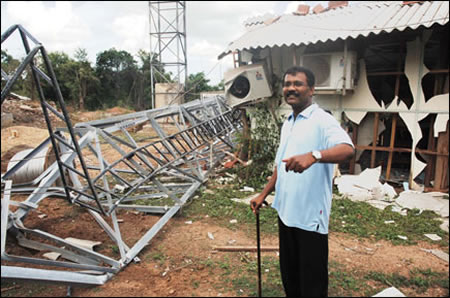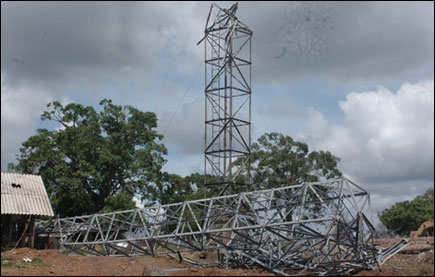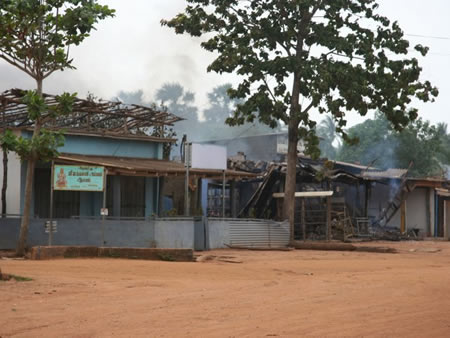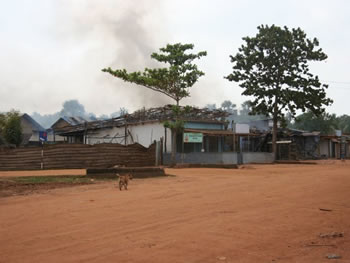
Ilankai Tamil Sangam
Association of Tamils of Sri Lanka in the USA
Published by Sangam.org
by Juan Manuel Velazquez, Diario El Tarde, Argentina, March 7, 2012
|
Demographic statistics speak for themselves. Taking, for example, the largest province of Sri Lanka, East (Eastern Province), nearly 10 thousand square kilometers along the coast of Bay of Bengal the Indian Ocean, the census figures from different times yielded of the colony of Ceylon until 2007, show a clear illustration of what precipitated the conflict and the genocide of Tamils. |
 |
Tras la derogación de la administración gubernamental Tamil de la Provincia del Noroeste e intervención gubernamental le siguió el ataque aéreo a la radio emisora La Voz de los Tigres del 17 de noviembre del 2007. Doce periodistas, entre ellos tres de los editores perdieron la vida y otros 15 civiles empleados fueron gravemente heridos. En total estallaron quince bombas sobre esas instalaciones, ganándose Sri Lanka la reputación de ser el tercer país más peligroso del mundo en lo que respecta a la seguridad de periodistas. |
After the defeat and annihilation of the LTTE fighters tigers, the legacy of the independence aspirations of the Tamil minority of Sri Lanka has left the aftermath of a humanitarian disaster that still persists today and it seems to have returned back to clockwise to the situation in the first place, led to the conflict and resistance against the government of Sinhala Buddhist majority south of the island. After the catalog of massacres began to suffer the Tamil minority by the majority Singali since 1957, segregation persists today as it was in 1977, when universal suffrage this minority decided for the independence of their territory, the motherland of Eelam, which, for administrative costs, the British had annexed the kingdom Singalis the south during the colonial administration in Ceylon.
 The strategy of strangulation socio-cultural and political current government against the Tamil minority is more than evident. Boot from the systematic occupation of land by 'settlers' singalies South, fostered by government planning policy Sinhala south. This strategy of occupation is based on the 'resettlement', the formation and proliferation throughout the territory of northern and northeastern urban settlements 'immigrants' singalies south, and all other kinds of measures 'demographic' to tip the balance and turn to the Tamils a minority in their own territory. In other words, doubly a minority both 'national' as they can or have now become in their own land of Eelam.
The strategy of strangulation socio-cultural and political current government against the Tamil minority is more than evident. Boot from the systematic occupation of land by 'settlers' singalies South, fostered by government planning policy Sinhala south. This strategy of occupation is based on the 'resettlement', the formation and proliferation throughout the territory of northern and northeastern urban settlements 'immigrants' singalies south, and all other kinds of measures 'demographic' to tip the balance and turn to the Tamils a minority in their own territory. In other words, doubly a minority both 'national' as they can or have now become in their own land of Eelam.
Demographic statistics speak for themselves. Taking, for example, the largest province of Sri Lanka, East (Eastern Province), nearly 10 thousand square kilometers along the coast of Bay of Bengal the Indian Ocean, the census figures from different times yielded of the colony of Ceylon until 2007, show a clear illustration of what precipitated the conflict and the genocide of Tamils.
The 1881 Census found that the percentage of the population was 58.96% Tamil while the Singalies of only 4.66% and others (35.99%) - between Muslims, Christians and Crios. In figures, 75,318 people and 5,947 Tamils living in Sangali ethnicity. But for 1981, although the Tamil population had reached over 400 000 ethnic percentage of the native community had fallen to 42% while Singalies with a population of 243,701 had risen to almost 25%, but together with other ethnic groups shared a slice-religious 58%, making the Tamils a minority in their own territory, this is in the Eastern Province of Sri Lanka, which covers an area equivalent to one third of the island.
For Census 2007, reversing the demographic trend continued at the expense of the Tamils, although since 1983 the territory of this had received tens of thousands of Tamils fleeing the slaughter of that year, between 5 000 and 6 000 were been killed during a single week by crowds of agitated Singalies by para-military government in the capital, Colombo, as well as fleeing the repression, harassment and robberies, murders, abductions and disappearances. Still, the Tamil population in 2007 only 40% scratching while Singalis remained above 21%, supported by programs of settlements and occupation of land and an influx of 'immigrants' Singalies encouraged by the government.
 |
Al desalojo y abandono de la población Tamil de sus tierras y localidades agrícolas le siguió la colonización del sur. |
The long and eventful political process launched in 1988 and through which had accelerated the events that precipitated in an armed conflict and civil war eventually broke out in 2007. On January 1 of that year, the proclamation of former President Jayewardene, based on the constitutional amendment of 1978 - and which established the temporary union of the provinces north and east in one administrative body governed by a regional government elected, was abolished. Under pressure from the nationalists and the military singalies, Tamil Northern Province and the Northwest was operated and managed directly by the central government in Colombo and the East, and East again segregated from Tamil Eelam.
Demographic statistics of 2010 are not available, but according to several sources contacted and connected with displaced families when living in north and east, officials from England Tamil Forum, Tamil Party and others, agree that the percentage Tamil population in the Eastern Province has grown by two possibilities: first, by  the exodus from south after the persecutions they suffered during the last decade but, second, that under pressure from the area north and northeast forced to move to the Eastern Province.
the exodus from south after the persecutions they suffered during the last decade but, second, that under pressure from the area north and northeast forced to move to the Eastern Province.
In the next installment Part VI (b) continues the approach of the abolition of press censorship and the iron that remained in the shadow of the Southern Sinhalese public opinion.
© 1996-2024 Ilankai Tamil Sangam, USA, Inc.